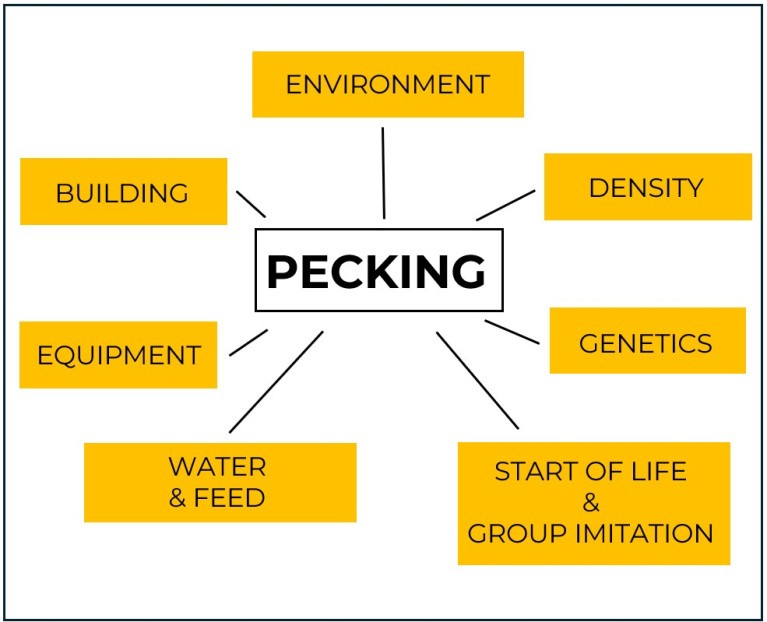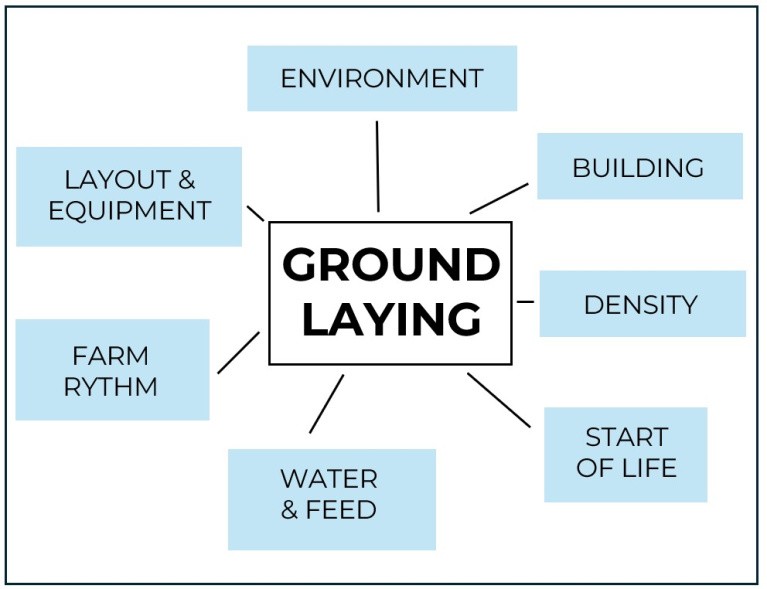Because animals are at the core of our metiers, paying close attention to their behaviour is a key driver of optimised production. Ethology, which is the study of animal behaviour, helps better understand favourable natural behaviours and those to avoid in order to ensure their well-being and good results.
In the “consumption eggs” sector, Alternative systems to cages are becoming more widespread (aviary, open-air and/or conservatory). In the meat sector, production methods are also evolving, with the modernisation of farms (enlargement and automation) and changes in practices (lower stocking densities, introduction of natural light). On these farms, poultry express a wider range of behaviours (stretching, dust bathing, exploring, etc.), which farmers and farm workers must learn to interpret.
Pecking in poultry: understanding the causes for better prevention
We have observed a hierarchy in farm-raised hens similar to how they behave in the wild. The order of access to resources (feed, water, enrichments, etc.) therefore depends on this social contact between individual animals. This is reflected in minor pecking from the dominant birds on the backs and heads of the submissive ones.
Poultry must also be able to express their natural behaviour of exploring the environment, which is aimed in particular at finding food. They can therefore be seen pecking at all kinds of surfaces: litter, equipment, feed, walls, etc.
Sometimes, the ideal circumstances for the expression of these behaviours are not present and can lead to "feather picking". Individuals will pluck feathers from their fellow birds; when there is bleeding, this can even lead to cannibalism (blood being appetising for poultry, which, let's not forget, are omnivores in the wild). Obviously, this type of behaviour is detrimental to the welfare of the animals and to production results, so we try to avoid it by taking preventive measures.

The cause of feather pecking is multifactorial. In other words, several factors can contribute to the animals’ frustration and eventually result in this disorder. There is no single specific triggering factor. We observe factors such as farm conditions (pullets and layers), transitioning between farms, social learning, building atmosphere, type of equipment used, genetics, water and feed quality, etc.
Our recommendations :
- Make sure the building’s atmosphere (T°, RH, CO2, NH3, etc.) complies with technical guidelines.
- Ensure a uniform distribution of light in the building, free of spots of light.
- Do not stimulate the chicks too early (at 1,250 g for white breeds (or 1,350 g for red breeds) with 80% homogeneity).
- Assess the feathering on pullets upon arrival: a lack of uniformity means the flock is at a higher risk.
- Enrichments are beneficial but should be diversified often to keep birds interested in them. Feed enrichments are even better, such as pecking blocks, alfalfa bales or insects.
- Avoid sudden changes in food presentation or composition. The food can also be enriched with fibre, as this increases the satiety effect in the animal, which will be less inclined to constantly explore its environment..
Poultry scratches: identifying risk factors and preventive solutions
Exploring the environment is an important activity for poultry. Both pecking and scratching are natural behaviours for this exploratory activity, which is used, among other things, to search for feed. Too little space, too much or the wrong kind of light, an unbalanced diet, the presence of parasites or sometimes even genetics can make the animals more agitated or nervous. These different conditions lead to inappropriate behaviour, as we saw earlier, but also to scratching.
Obviously, this type of behaviour is detrimental to the animals' well-being and production results, so we try to avoid it by taking preventive measures.

Our recommendations:
- Ensure that the environment in the building (T°, RH, CO2, NH3, etc.) complies with the technical guide.
- Ensure that there is enough equipment for the animals, and that there are no gaps in the chain or excessively long breaks in the light (especially in the meat sector).
- Make sure that light is evenly distributed in the building, without "spotlights". Do not stimulate pullets too early (at 1350g for red strains (or 1250g for white strains) with 80% homogeneity).
- Avoid sudden changes in feed presentation or composition. The feed can also be enriched with fibre, as this increases the satiety effect in the animal, which will therefore be less inclined to constantly explore its environment.
Ground laying
In alternative livestock systems, nests are provided for hens to lay eggs, which are then sent to a separate biosecurity-compliant building zone for sorting. When hens lay outside of their nests, it is called “ground laying”. This behaviour poses a problem because eggs can break, are more fragile, dirtier and waste time for breeders who must collect them.
For a given layer, the sequence of behaviours leading up to laying is nearly always the same: during this period of approximately 30 minutes, she will search for a place to lay. Less than optimal conditions may cause the hen to be unsatisfied with the nest and she will thus adopt a bad habit of laying elsewhere. However, if breeders are attentive to certain factors, the hen can be trained to lay in the desired spot.

Our recommendations:
- Ensure a uniform distribution of light in the building, especially in darker areas and corners.
- Stimulate the chicks at the right moment (at 1,250 g for white breeds (or 1,350 g for red breeds) with 80% homogeneity).
- Empty the feed trough once a day, preferably in the second half of the morning, as this will not encourage the hens to come and feed and lay eggs outside the nest.
- Check the water supply (no water cuts, sufficient pressure, quality, etc.).
- Place a light (10 lux) in the nests to attract the first hens to lay eggs in the morning.
- Make the nests attractive:
- No residual smell after cleaning the building.
- Properly heated nests, without draughts.
- If possible, use a substrate suited to the expression of pre-laying behaviour in the nests: artificial grass or rubber pimples are a good compromise between the needs of the animals and those of the breeders.
- Do not place perches too close to the nest openings, as perching animals will block access to the nests.

Techna's support for nervous poultry
As poultry production methods evolve to meet society's expectations, certain practices need to be reconsidered to avoid these problematic behaviours. Our experts can help you adapt your rearing practices, thanks to their expertise in poultry behaviour and in rearing as a whole. Our passionflower-based product GALLICALM, renowned for its calming effects, can also help you manage nervousness and implement our experts' recommendations, so you can work more calmly. Don't hesitate to ask our experts!
Talk to our experts
Feedia embodies Techna's range of advice and solutions in breeding techniques and precision nutrition, serving the performance of production organisations, feed manufacturers and their breeder customers.

